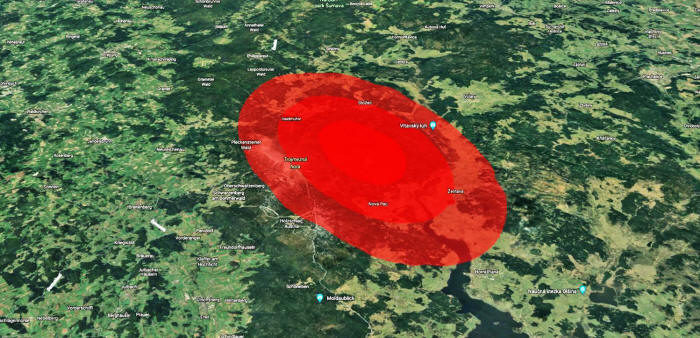|

by Robby Berman
May 05, 2021
from
BigThink Website

Credit: NASA/JPL
-
At an international
space conference, attendees took part in an 'exercise'
that imagined an asteroid crashing into Earth.
-
With the object first
spotted six months before impact, attendees
concluded that there was insufficient time for a
meaningful response.
-
There are an estimated
25,000 near-Earth objects potentially threatening
our planet.
The
asteroid 2021 PDC was first
spotted on April 19, 2021 by the
Pan-STARRS project
at the University of Hawaii.
By May 2, astronomers were 100%
certain it was going to strike Earth somewhere in Europe or northern
Africa.
On October 20, 2021, the asteroid plowed into Europe, taking
countless lives.
There was absolutely nothing anyone
could do to deflect it from its deadly course.
Experts could only warn a
panicking population to get out of the way as soon as possible,
if it was possible.
The above scenario
is the result of a recently concluded NASA thought experiment...
The question the
agency sought to answer was this:
If we discovered a potentially
deadly asteroid destined to hit Earth in six months, was there
anything we could do to prevent a horrifying catastrophe?
The
disturbing answer is "no," not with currently available technology.
While Europe can
breathe easy for now, the
simulation conducted by NASA/JPL's Center for Near Earth Object
Studies and presented at the
7th IAA Planetary Defense Conference is troubling.
Space agencies spot
"near-Earth objects" (NEOs) all the time.
Many are larger than 140
meters in size, which means they're potentially deadly.
Sitting Ducks

Credit: ImageBank4U
Adobe Stock
"The level [at]
which we're finding the 140-meter and larger asteroids remains
pretty stable, at about 500 a year.
Our projection
of the number of these objects out there is about 25,000, and
we've only found a little over one-third of those so far, maybe
38% or so," NASA's Planetary Defense Office
Lindley Johnson tells
Space.com.
With our current
technology, spotting an NEO comes down to whether we just happen to
have a telescope pointing in its direction.
To remove
humanity's blind spot, NASA is developing the
NEO Surveyor spacecraft, which they plan to deploy in 2025. The
project is being supported by the Planetary Society, the same
organization that deployed
Earth's first light sails.
According to the
Planetary Society, NEO Surveyor will be able to detect 90 percent of
NEOs of 140 meters or larger, a vast improvement.
How to move an asteroid

The DART spacecraft
will attempt to deflect an asteroid.
Credit: NASA
The NASA/JPL
exercise made clear that six months is just not enough time with our
current technology to prepare and launch a mission in time to nudge
an NEO off its course.
(Small course adjustments become significant
over great distances, which is why "nudging" an asteroid is a
potential strategy.)
What would such a
mission look like? Hollywood aside - remember
Armageddon? - we know of no good way to redirect a NEO
headed our way.
Experts believe
that shooting laser beams at an incoming rock, exciting as it might
look, is not a realistic possibility.
Targeted nuclear blasts might work, but forget about landing
Bruce Willis, Ben Affleck, and Liv Tyler on an asteroid to set off a
course-altering bomb, especially just a month after its discovery
(as was the case in the movie).
Another thing that
might work is crashing a spacecraft into an NEO hard enough to shift
its course. That's the idea behind NASA's
Double Asteroid Redirection Test (DART).
This mission will
shoot a spacecraft at the (non-threatening) asteroid
Dimorphos in
the fall of 2022 in the hope of changing its trajectory.
The deadly asteroid's
journey

The asteroid "2021 PDC"
hit Europe in NASA's simulation.
Credit: NASA/JPL
The harrowing
"tabletop exercise," as NASA/JPL called it, took place across four
days at the conference:
-
Day 1,
"April 19"
The asteroid named "2021 PDC" is discovered 35
million miles away. Scientists calculate it has a 1-in-20
chance of striking Earth.
-
Day 2, "May
2"
Now certain that 2021 PDC will hit Earth, space mission
designers attempt to dream up a response.
They
conclude that with less than six months to impact, there's
not enough time to realistically mount a mission to disrupt
the NEO's course.
-
Day 3,
"June 30"
Images from the world's four largest telescopes
reveal the area in Europe that will be hit.
Space-based
infrared measurements narrow the object's size to between 35
and 700 meters. This would pack a similar punch as a
1.2-megaton nuclear bomb.
-
Day 4,
"October 14"
Six days before impact, the asteroid is just
6.3 million km from Earth.
Finally,
the Goldstone Solar System Radar has been able to assess the
size of 2021 PDC.
Scientists
calculate the blast from the asteroid will be primarily
confined to the border region between Germany, Czechia,
Austria, Slovenia, and Croatia. Disaster response experts
develop plans for addressing the human toll.
"Each time we
participate in an exercise of this nature,"
says Johnson, "we learn more about who the key players are
in a disaster event, and who needs to know what information, and
when."
Practically
speaking, little can be done to hurry technological development
along other than budgeting more money toward that goal.
Maybe we
should have Bruce Willis on call, just in case...
| 




